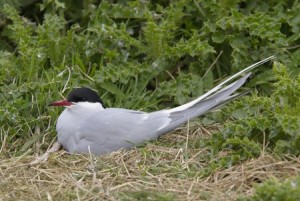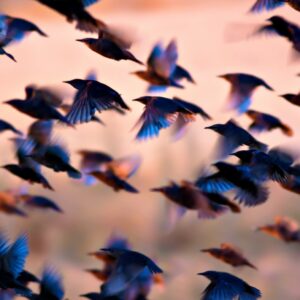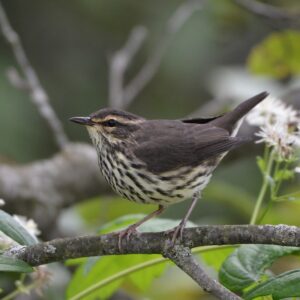“Motherload” Migration at Manitoba Important Bird Area

Charlie McPherson is the sole Important Bird Area Caretaker for Manitoba, which launched its Caretaker program this spring. He watches over and protects the Netly-Libau Marsh Important Bird Area (IBA). Last month, Charlie visited his IBA on Mother’s Day. Here’s his account of what he saw.I drove down to the north-west corner of the Netly-Libau Marsh yesterday, Mother’s Day morning at 8:30 a.m. and stayed until 11:30 a.m. I could hardly believe my eyes. I landed in the midst of a migration motherload at the end of Warner Rd. You’re at the south-west corner of Lake Winnipeg when at the end of that road. It’s just a half mile south of Matlock. It’s not an all weather road but it’s dry.I thought I might pick up a few shorebirds working the muck along the beach by going there. I got shorebirds alright – hundreds and hundreds of them, but not working muck. They were migrating in small flocks (average about 6-20) all throughout my 3 hour sit. I needed a shorebird expert, no doubt about it, to identify these guys as I’m not all that familiar with shorebirds zooming by that fast in flight. I did manage to identify a few though: a Solitary, a Marbled Godwit, and at least one Greater and one Lesser Y-legs as these few obliged me with a brief stop.
What was AMAZING was the number of Rose-breasted Grosbeaks and Baltimore Orioles that kept scooting by (they seemed to be travelling together). If a Grosbeak whizzed by, a couple of Orioles (or three or four or more) were sure to be whizzing by as well, as were two or three or four or more Grosbeaks etc. This pattern was repeated all through the 3 hour observation time. And along with them were streaming numbers of all kinds of other species. We’re not talking clouds of migrators here, just a steady flow of birds pretty much non-stop. Most all of the migrating birds were just over, or at, tree height or lower (more often lower) especially through the treeless sand beach area between the lake and the marsh. They’d just swoop right down. One Grosbeak almost took my head off – ha! The migrating stream included lots of small flocks of Barn and Tree Swallows, small and larger flocks of Grackles and Blackbirds, 3 Cooper’s and 6 Sharpies, a couple dozen Blue Jays coming two or three or more at a time, a half dozen crows and large numbers of all kinds of dickie birds – a steady stream of ‘difficult to identify in flight’ small groups of mixed species Warblers and Sparrows in small wave, after small wave, after small wave, all morning long. Hardly was there a moment when something wasn’t on the move.
Thankfully, there’s an isolated 40 foot diameter bluff of trees growing out of what used to be a homestead at the end of the road. Most birds ignored the bluff, although some flew right through it, but some would stop for a minute or two (only) giving me a chance to identify them – Palm, Common Yellow-throat, Northern Water thrush, Blackpoll, Yellow etc, along with an assortment of sparrows, East/West Kingbirds (more West than East). In total too many birds coming too fast to even count.
A half silvery moon stood watch at 12:00 in the sky. I might have missed that had it not been for 17 White Pelicans soaring beneath it. Throughout the sit I picked up (lake side) a couple dozen Common Terns, 23 Ring-billed Gulls, 5 Western Grebes, 4 Hooded Mergansers, 2 Wood Ducks, 2 Mallards, 2 Blue-winged Teal, 8 American Goldeneye, a dozen or so Canada Geese, and about a dozen either Ring-necked or Lesser Scaup in flight way off in the distance. Also one Great-blue Heron, one Bald Eagle and 6 Ravens. I wondered how birds migrating along this corridor numbered two or three hundred years ago? Hordes I bet. I’m guessing that the numbers migrating up the Red, through the marsh, and then following the lakeshore west to Warner Rd would probably be similar to the numbers turning east to follow the lakeshore east to Beaconia Beach and Grand Beach and surrounds northward. It’d be nice to sit that shoreline some day, too, when there’s a push like this happening. The wind was ‘branches swaying stiff’ out of the west.
The Netly-Libau Marsh was designated an IBA for its moulting ducks and fall migrants (water birds, swallows, blackbirds etc), as well as for some fair numbers of nesting herons, terns and gulls. After witnessing what I just witnessed, I would say that it should be noted as being an important corridor for its spring migrants as well. It’s not often that one gets to get in on a motherload like that. I’m convinced the birds had been going all night and were simply trucking on into the day. They do that when the they leave the Yucatan Peninsula – motor the 18 hour flight over the gulf and if they don’t run into headwinds by the time they reach the Texas and Louisiana coastlines they just keep right on going to the forests north of I-10, so says Audubon. A fellow birder told me later that he got in on the motherload a few hours earlier – a mile east – from sunrise to 6:30 a.m.
It’s going to take a whole lot of effort by a whole lot of people to save the lake/marsh. I feel it’s important that our IBA stakeholder interests in the marsh are heard and met. Two big positives that I see are: the marsh is somewhat self protecting because it is inaccessible but by boat for the most part. Save the marsh, save the birds, grow the birding economy.
Although Charlie recently joined the IBA Caretaker network, he’s not new to birding. He has taken part in bird atlasing for Manitoba and had taken groups to the Netly-Libau IBA as part of his atlasing. Currently, Charlie is working with the mayor of Whytewold town and a local restaurant owner to create a space in a community building to run an IBA educational program, birding group, art and garden centre.
Charlie is part of a network of over 200 volunteers who watch over and protect Important Bird Areas across Canada. As the national sponsor of the Important Bird Area Caretaker Network, TransCanada Corporation committed $1 million in 2009 to support bird conservation efforts in Canada over the following five years.



